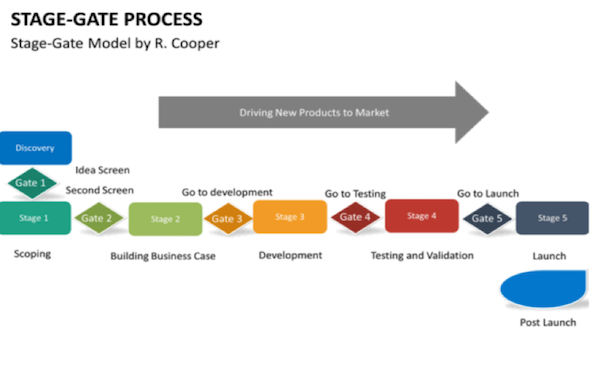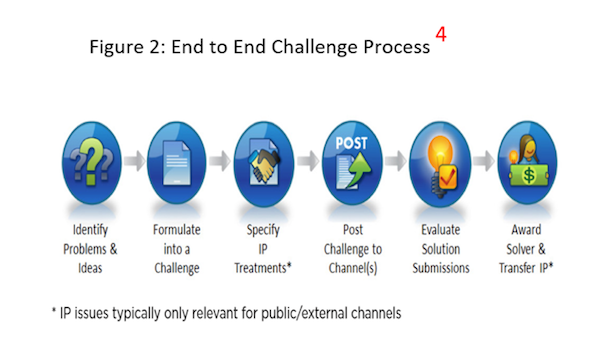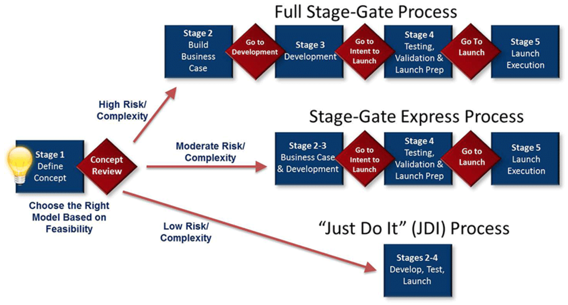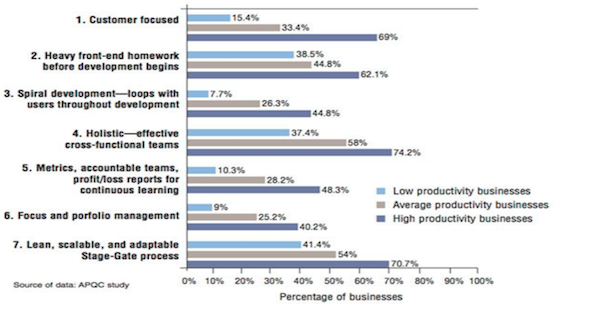As Part of a Business Transformation and Enterprise Excellence strategy, how can the business be challenged to innovate and improve products?
A Robust New Product Introduction (NPI) Process should be a core competency at all companies.
Let’s take a look at the methodology and set of tools/techniques of a Stage Gate Process.2
The concept of a Stage Gate Process was described by Robert Cooper in the early 1980’s as a framework for the NPI process3. In its simplest form, it is a series of distinct Stages separated by “Go/No Go” decision points called Gates. Gate Reviews are typically cross-function business reviews designed with standardized criteria to move the process to the next Stage or to make a business decision either to (1) suspend the product development process until risks/gaps are resolved or (2) “kill” the new product program.

“In practice, the stages shown may include numerous substages and gates depending on how the process has been defined and structured within a specific sector or company. This is particularly true when Challenges are leveraged to supplement Stage Gates, companies can achieve near infinite problem-solving capacity and pay only for solutions, not failure”4. A Challenge is a well-formed problem statement that brings added value to a company. Challenges come in a variety of forms and can occur anywhere across the Stage Gate Process. By definition, Challenges are specific, detailed, and actionable.


Does most NPI follow a standard process? And if so, what is the value that companies have experienced?
According to research by Nielsen, companies that have gated innovation processes average 130% more new product revenue than companies with informal processes 5.
Stage Gate Process variants
Depending on the maturity of a company’s NPI process and the complexity/risk behind the product being introduced, the Stage Gate process can fall into various types 6 & 7:

For more detailed overviews, there are numerous websites and articles around the Stage Gate Process8.
With such fundamental ways a Stage Gate Process can improve a business, what are Best Practices to consider?
Work by Cooper identified seven High Productivity areas 9:

Best in Class Stage Gate Practices to consider:
- Mission-Vision-Values statements are critical – links to Business Challenge(s) and Stage Gate Process execution
- Internal & External benchmarking is key … keeping a customer focused approach
- Value Stream Mapping (VSM) Analysis … “As-Is” and “To-Be”
- Leverage process improvement tools (5S, Standard Work, Operational/Analytical Methods, Visual Management, etc.)
- Design based on Future State Benchmarking
- Mission Critical Work Streams Identified with appropriate Functional and Management Group structures
- VSM Process flow into discrete Stages separated by Gates to make go/no go decisions
- Challenges to “As-Is” Stage Gate Process … Sub Stages and Gates developed
- Playbook developed to standardize elements of Future State Stage Gate Process
- One Integrated Plan/Standard Process
- Multi-Functional and Cross-Team Collaboration requirements are defined and integrated into Process, Risk Management at lowest level of organization; Leadership – Coaching/Mentoring of Stage Gate Process/People, Risk Escalation/Critical Business Decision Making only
- Communications – Well developed and fully deployed communication plan across functional teams and senior leadership
- Empowerment to Functional Team(s) and site(s) for decision making
- Rapid Decision Making built into Process
- Risk Management and Escalation defined for Leadership engagement
- Process Evolution, Robustness, and Standardization of Process developed to include Innovation, Portfolio Management, Risk Management, and Sustainability
Engaging Cultural, Strategic, and Behavioral Challenges
What would you like to see in future articles on how Best-In-Class companies are leveraging the methodologies, tools and techniques of Enterprise Excellence for success?
References:
- “OpEx-PART OF or SEPARATE FROM Business Transformation?”, Leonard R Hepp, BPMInstitute.org, May 11 2017.
- Note: “The Stage-Gate® process is a patented trademark of Dr Robert Cooper”.
- Stage-Gate Systems: A New Tool for Managing New Products, Robert Cooper, Business Horizons / May-June 1990.
- Challenges to Stage Gate Process. Executive White Paper.
- Nielsen “Secret to Successful New Product Innovation: Keep the Boss Out of It”, 16 June 2010
Stage-Gate® is a registered trademark of Stage-Gate Inc - “Formula For Success In New Product Development“ by Robert G. Cooper, Marketing Management Magazine, March/April 2006.
- Stage-Gate Innovation Process and Automation.
- Stage Gate Process – Innovation, Portfolio Management, New Product Development, Cooper, Robert G. “What’s Next?: After Stage-Gate.” Research-Technology Management 57, no. 1 (2014): 20-31 , and Edgett, Scott J. “Idea‐to‐Launch (Stage‐Gate®) Model: An Overview.” Stage-gate Inc. (2015).
- “The seven principles of the latest Stage-Gate® method add up to a streamlined, new product idea-t0-launch process” by Cooper, Robert G, Stage-gate Inc. (2006).

















